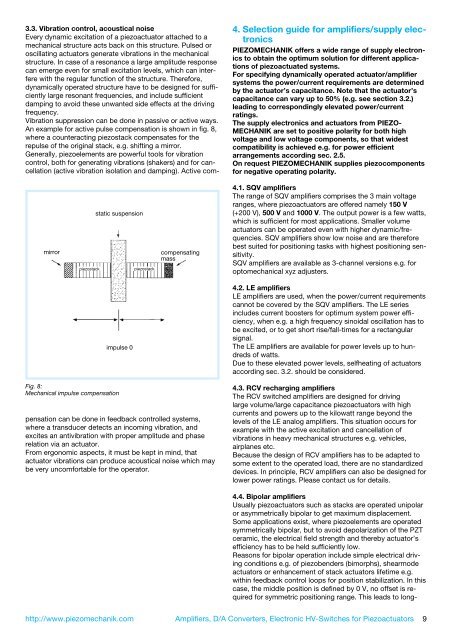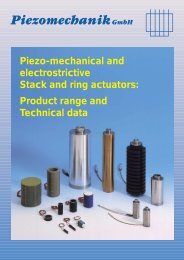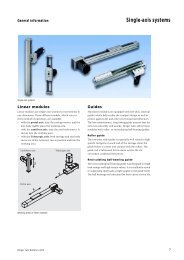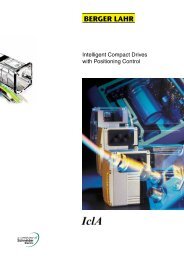Piezomechanik
Piezomechanik
Piezomechanik
You also want an ePaper? Increase the reach of your titles
YUMPU automatically turns print PDFs into web optimized ePapers that Google loves.
3.3. Vibration control, acoustical noise<br />
Every dynamic excitation of a piezoactuator attached to a<br />
mechanical structure acts back on this structure. Pulsed or<br />
oscillating actuators generate vibrations in the mechanical<br />
structure. In case of a resonance a large amplitude response<br />
can emerge even for small excitation levels, which can interfere<br />
with the regular function of the structure. Therefore,<br />
dynamically operated structure have to be designed for sufficiently<br />
large resonant frequencies, and include sufficient<br />
damping to avoid these unwanted side effects at the driving<br />
frequency.<br />
Vibration suppression can be done in passive or active ways.<br />
An example for active pulse compensation is shown in fig. 8,<br />
where a counteracting piezostack compensates for the<br />
repulse of the original stack, e.g. shifting a mirror.<br />
Generally, piezoelements are powerful tools for vibration<br />
control, both for generating vibrations (shakers) and for cancellation<br />
(active vibration isolation and damping). Active com-<br />
static suspension<br />
mirror compensating<br />
mass<br />
piezostack piezostack<br />
impulse 0<br />
Fig. 8:<br />
Mechanical impulse compensation<br />
pensation can be done in feedback controlled systems,<br />
where a transducer detects an incoming vibration, and<br />
excites an antivibration with proper amplitude and phase<br />
relation via an actuator.<br />
From ergonomic aspects, it must be kept in mind, that<br />
actuator vibrations can produce acoustical noise which may<br />
be very uncomfortable for the operator.<br />
4. Selection guide for amplifiers/supply electronics<br />
PIEZOMECHANIK offers a wide range of supply electronics<br />
to obtain the optimum solution for different applications<br />
of piezoactuated systems.<br />
For specifying dynamically operated actuator/amplifier<br />
systems the power/current requirements are determined<br />
by the actuator’s capacitance. Note that the actuator’s<br />
capacitance can vary up to 50% (e.g. see section 3.2.)<br />
leading to correspondingly elevated power/current<br />
ratings.<br />
The supply electronics and actuators from PIEZO-<br />
MECHANIK are set to positive polarity for both high<br />
voltage and low voltage components, so that widest<br />
compatibility is achieved e.g. for power efficient<br />
arrangements according sec. 2.5.<br />
On request PIEZOMECHANIK supplies piezocomponents<br />
for negative operating polarity.<br />
4.1. SQV amplifiers<br />
The range of SQV amplifiers comprises the 3 main voltage<br />
ranges, where piezoactuators are offered namely 150 V<br />
(+200 V), 500 V and 1000 V. The output power is a few watts,<br />
which is sufficient for most applications. Smaller volume<br />
actuators can be operated even with higher dynamic/frequencies.<br />
SQV amplifiers show low noise and are therefore<br />
best suited for positioning tasks with highest positioning sensitivity.<br />
SQV amplifiers are available as 3-channel versions e.g. for<br />
optomechanical xyz adjusters.<br />
4.2. LE amplifiers<br />
LE amplifiers are used, when the power/current requirements<br />
cannot be covered by the SQV amplifiers. The LE series<br />
includes current boosters for optimum system power efficiency,<br />
when e.g. a high frequency sinoidal oscillation has to<br />
be excited, or to get short rise/fall-times for a rectangular<br />
signal.<br />
The LE amplifiers are available for power levels up to hundreds<br />
of watts.<br />
Due to these elevated power levels, selfheating of actuators<br />
according sec. 3.2. should be considered.<br />
4.3. RCV recharging amplifiers<br />
The RCV switched amplifiers are designed for driving<br />
large volume/large capacitance piezoactuators with high<br />
currents and powers up to the kilowatt range beyond the<br />
levels of the LE analog amplifiers. This situation occurs for<br />
example with the active excitation and cancellation of<br />
vibrations in heavy mechanical structures e.g. vehicles,<br />
airplanes etc.<br />
Because the design of RCV amplifiers has to be adapted to<br />
some extent to the operated load, there are no standardized<br />
devices. In principle, RCV amplifiers can also be designed for<br />
lower power ratings. Please contact us for details.<br />
4.4. Bipolar amplifiers<br />
Usually piezoactuators such as stacks are operated unipolar<br />
or asymmetrically bipolar to get maximum displacement.<br />
Some applications exist, where piezoelements are operated<br />
symmetrically bipolar, but to avoid depolarization of the PZT<br />
ceramic, the electrical field strength and thereby actuator’s<br />
efficiency has to be held sufficiently low.<br />
Reasons for bipolar operation include simple electrical driving<br />
conditions e.g. of piezobenders (bimorphs), shearmode<br />
actuators or enhancement of stack actuators lifetime e.g.<br />
within feedback control loops for position stabilization. In this<br />
case, the middle position is defined by 0 V, no offset is required<br />
for symmetric positioning range. This leads to long-<br />
http://www.piezomechanik.com Amplifiers, D/A Converters, Electronic HV-Switches for Piezoactuators<br />
9






